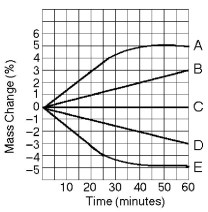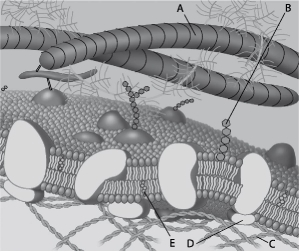Exam 5: Membrane Transport and Cell Signaling
Exam 1: Introduction: Evolution and the Foundations of Biology36 Questions
Exam 2: The Chemical Context of Life135 Questions
Exam 3: Carbon and the Molecular Diversity of Life121 Questions
Exam 4: A Tour of the Cell72 Questions
Exam 5: Membrane Transport and Cell Signaling89 Questions
Exam 6: An Introduction to Metabolism74 Questions
Exam 7: Cellular Respiration and Fermentation90 Questions
Exam 8: Photosynthesis71 Questions
Exam 9: The Cell Cycle63 Questions
Exam 10: Meiosis and Sexual Life Cycles65 Questions
Exam 11: Mendel and the Gene Idea65 Questions
Exam 12: The Chromosomal Basis of Inheritance46 Questions
Exam 13: The Molecular Basis of Inheritance68 Questions
Exam 14: Gene Expression: From Gene to Protein83 Questions
Exam 15: Regulation of Gene Expression53 Questions
Exam 16: Development, Stem Cells, and Cancer34 Questions
Exam 17: Viruses35 Questions
Exam 18: Genomes and Their Evolution31 Questions
Exam 19: Descent With Modification54 Questions
Exam 20: Phylogeny53 Questions
Exam 21: The Evolution of Populations69 Questions
Exam 22: The Origin of Species60 Questions
Exam 23: Broad Patterns of Evolution38 Questions
Exam 24: Early Life and the Diversification of Prokaryotes89 Questions
Exam 25: The Origin and Diversification of Eukaryotes71 Questions
Exam 26: The Colonization of Land by Plants and Fungi153 Questions
Exam 27: The Rise of Animal Diversity107 Questions
Exam 28: Plant Structure and Growth50 Questions
Exam 29: Resource Acquisition, Nutrition, and Transport in Vascular Plants130 Questions
Exam 30: Reproduction and Domestication of Flowering Plants68 Questions
Exam 31: Plant Responses to Internal and External Signals71 Questions
Exam 32: Homeostasis and Endocrine Signaling122 Questions
Exam 33: Animal Nutrition61 Questions
Exam 34: Circulation and Gas Exchange77 Questions
Exam 35: The Immune System84 Questions
Exam 36: Reproduction and Development109 Questions
Exam 37: Neurons, Synapses, and Signaling68 Questions
Exam 38: Nervous and Sensory Systems89 Questions
Exam 39: Motor Mechanisms and Behavior74 Questions
Exam 40: Population Ecology and the Distribution of Organisms92 Questions
Exam 41: Species Interactions55 Questions
Exam 42: Ecosystems and Energy79 Questions
Exam 43: Global Ecology and Conservation Biology70 Questions
Select questions type
The presence of cholesterol in the plasma membranes of some animals
(Multiple Choice)
5.0/5  (29)
(29)
 Figure 5.4
Five dialysis bags, constructed from a semipermeable membrane that is impermeable to sucrose, were filled with various concentrations of sucrose and then placed in separate beakers containing an initial concentration of 0.6 M sucrose solution. At 10-minute intervals, the bags were massed (weighed) and the percent change in mass of each bag was graphed.
-Which line in the graph represents the bag with the highest initial concentration of sucrose?
Figure 5.4
Five dialysis bags, constructed from a semipermeable membrane that is impermeable to sucrose, were filled with various concentrations of sucrose and then placed in separate beakers containing an initial concentration of 0.6 M sucrose solution. At 10-minute intervals, the bags were massed (weighed) and the percent change in mass of each bag was graphed.
-Which line in the graph represents the bag with the highest initial concentration of sucrose?
(Multiple Choice)
4.9/5  (25)
(25)
Proton pumps are used in various ways by members of every domain of organisms: Bacteria, Archaea, and Eukarya. What does this most probably mean?
(Multiple Choice)
4.9/5  (35)
(35)
The primary function of polysaccharides attached to the glycoproteins and glycolipids of animal cell membranes is
(Multiple Choice)
4.8/5  (44)
(44)
Use this description to answer the following question.
A major group of G-protein-coupled receptors contains seven transmembrane α helices. The amino end of the protein lies at the exterior of the plasma membrane. Loops of amino acids connect the helices either at the exterior face or on the cytosol face of the membrane. The loop on the cytosol side between helices 5 and 6 is usually substantially longer than the others.
-Which of the following factors would tend to increase membrane fluidity?
(Multiple Choice)
4.8/5  (29)
(29)
Ions diffuse across membranes through specific ion channels
(Multiple Choice)
5.0/5  (32)
(32)
 Figure 5.1
For the following questions, match the labeled component of the cell membrane in Figure 5.1 with its description.
-Which component is a microfilament of the cytoskeleton?
Figure 5.1
For the following questions, match the labeled component of the cell membrane in Figure 5.1 with its description.
-Which component is a microfilament of the cytoskeleton?
(Multiple Choice)
4.8/5  (25)
(25)
Which of the following is the greatest advantage of having multiple steps in a transduction pathway?
(Multiple Choice)
4.7/5  (35)
(35)
Use this description to answer the following question.
A major group of G-protein-coupled receptors contains seven transmembrane α helices. The amino end of the protein lies at the exterior of the plasma membrane. Loops of amino acids connect the helices either at the exterior face or on the cytosol face of the membrane. The loop on the cytosol side between helices 5 and 6 is usually substantially longer than the others.
-Which of the following processes includes all the others?
(Multiple Choice)
4.9/5  (41)
(41)
Use this description to answer the following question.
A major group of G-protein-coupled receptors contains seven transmembrane α helices. The amino end of the protein lies at the exterior of the plasma membrane. Loops of amino acids connect the helices either at the exterior face or on the cytosol face of the membrane. The loop on the cytosol side between helices 5 and 6 is usually substantially longer than the others.
-If an animal cell suddenly lost the ability to produce GTP, what might happen to its signaling system?
(Multiple Choice)
4.8/5  (33)
(33)
The sodium-potassium pump is called an electrogenic pump because it
(Multiple Choice)
4.9/5  (40)
(40)
 Figure 5.1
For the following questions, match the labeled component of the cell membrane in Figure 5.1 with its description.
-Which component is cholesterol?
Figure 5.1
For the following questions, match the labeled component of the cell membrane in Figure 5.1 with its description.
-Which component is cholesterol?
(Multiple Choice)
4.9/5  (36)
(36)
In which of the following ways do plant hormones differ from hormones in animals?
(Multiple Choice)
4.9/5  (36)
(36)
Cell membranes are asymmetrical. Which of the following statements is the most likely explanation for the membrane's asymmetrical nature?
(Multiple Choice)
5.0/5  (35)
(35)
Mammalian blood contains the equivalent of 0.15 M NaCl. Seawater contains the equivalent of 0.45 M NaCl. What will happen if red blood cells are transferred to seawater?
(Multiple Choice)
4.8/5  (28)
(28)
The movement of the hydrophobic gas nitrous oxide (N2O) (laughing gas) into a cell is an example of
(Multiple Choice)
4.8/5  (31)
(31)
When a membrane is freeze-fractured, the bilayer splits down the middle between the two layers of phospholipids. In an electron micrograph of a freeze-fractured membrane, the bumps seen on the fractured surface of the membrane are
(Multiple Choice)
4.9/5  (47)
(47)
When a neuron responds to a particular neurotransmitter by opening gated ion channels, the neurotransmitter is serving as which part of the signal pathway?
(Multiple Choice)
4.8/5  (38)
(38)
Glucose diffuses slowly through artificial phospholipid bilayers. The cells lining the small intestine, however, rapidly move large quantities of glucose from the glucose-rich food into their glucose-poor cytoplasm. Using this information, which transport mechanism is most probably functioning in the intestinal cells?
(Multiple Choice)
4.8/5  (30)
(30)
A bacterium engulfed by a white blood cell through phagocytosis will be digested by enzymes contained in
(Multiple Choice)
4.9/5  (32)
(32)
Showing 41 - 60 of 89
Filters
- Essay(0)
- Multiple Choice(0)
- Short Answer(0)
- True False(0)
- Matching(0)